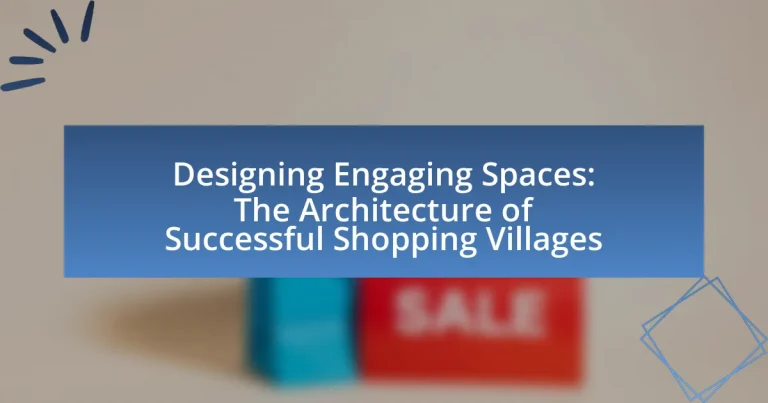The article focuses on the architecture and design of shopping villages, which are open-air retail developments that combine shopping, dining, and entertainment to create engaging consumer experiences. It highlights the importance of design elements such as layout, aesthetics, and functionality in attracting customers and fostering community engagement. Key components discussed include the role of landscaping, public spaces, and sustainability in enhancing shopper behavior and satisfaction. Additionally, the article addresses challenges in design, best practices for creating vibrant environments, and the impact of technology on the shopping experience, emphasizing the need for adaptability in future designs.

What are Shopping Villages and Their Importance in Modern Retail?
Shopping villages are retail developments that combine a variety of shops, restaurants, and entertainment options in an open-air environment, designed to create a unique shopping experience. Their importance in modern retail lies in their ability to attract consumers seeking both leisure and shopping, fostering a sense of community and enhancing customer engagement. According to a report by the International Council of Shopping Centers, shopping villages have seen a rise in popularity due to their experiential nature, which encourages longer visits and increased spending. This trend reflects a shift in consumer preferences towards environments that offer more than just transactional shopping, emphasizing the need for retailers to adapt to these evolving expectations.
How do Shopping Villages differ from traditional shopping centers?
Shopping Villages differ from traditional shopping centers primarily in their design and experiential focus. Shopping Villages are typically designed to create a more open, outdoor environment that encourages leisurely exploration, often featuring unique architectural styles and landscaping that enhance the shopping experience. In contrast, traditional shopping centers usually consist of enclosed spaces with a more utilitarian layout, prioritizing efficiency and convenience over ambiance. This distinction is supported by the trend in consumer preferences, where studies indicate that shoppers increasingly seek experiences and environments that foster social interaction and relaxation, which Shopping Villages provide more effectively than conventional shopping centers.
What architectural features define a shopping village?
Shopping villages are characterized by architectural features that promote a cohesive and inviting environment. Key features include pedestrian-friendly layouts, which prioritize walkability and accessibility, often incorporating wide sidewalks and open plazas. Additionally, shopping villages typically feature a mix of building styles that reflect local culture and history, creating visual interest and a sense of place. Rooflines are often varied to enhance the aesthetic appeal, while the use of natural materials like wood and stone fosters a connection to the surrounding landscape. Landscaping elements, such as trees and gardens, are integrated to enhance the outdoor experience and provide shade. These features collectively contribute to a vibrant atmosphere that encourages social interaction and enhances the shopping experience.
Why are shopping villages becoming more popular among consumers?
Shopping villages are becoming more popular among consumers due to their unique blend of shopping, dining, and leisure experiences in an open-air environment. This format allows for a more relaxed and enjoyable shopping experience compared to traditional malls, which often feel crowded and impersonal. The appeal of shopping villages is further enhanced by their focus on local and artisanal products, which resonate with consumers seeking authenticity and community connection. Additionally, the integration of green spaces and aesthetically pleasing architecture contributes to a pleasant atmosphere, encouraging longer visits and repeat patronage. According to a report by the International Council of Shopping Centers, 70% of consumers prefer shopping in environments that offer a mix of retail and leisure activities, highlighting the growing demand for such spaces.
What role does design play in the success of shopping villages?
Design plays a crucial role in the success of shopping villages by enhancing customer experience and driving foot traffic. Effective design elements, such as layout, aesthetics, and functionality, create inviting environments that encourage visitors to explore and spend time in the space. For instance, research indicates that well-designed shopping areas can increase dwell time by up to 30%, leading to higher sales per visitor. Additionally, incorporating natural elements and pedestrian-friendly pathways fosters a sense of community and engagement, which is essential for attracting repeat customers. Thus, thoughtful design directly impacts the commercial viability and popularity of shopping villages.
How can layout and flow enhance the shopping experience?
Layout and flow significantly enhance the shopping experience by guiding customers through a space in a way that encourages exploration and engagement. A well-designed layout strategically places products and services to create a logical path, reducing confusion and frustration. For instance, research from the Journal of Retailing indicates that stores with clear pathways and organized sections can increase customer dwell time by up to 20%, leading to higher sales. Additionally, effective flow minimizes bottlenecks and enhances accessibility, allowing shoppers to navigate easily, which contributes to a more enjoyable and efficient shopping experience.
What elements contribute to creating an inviting atmosphere?
Elements that contribute to creating an inviting atmosphere include lighting, color schemes, furniture arrangement, and sensory experiences. Effective lighting enhances visibility and mood, while warm color schemes create a welcoming environment. Thoughtful furniture arrangement encourages social interaction and comfort, and sensory experiences, such as pleasant scents and sounds, further engage visitors. Research indicates that environments designed with these elements can increase visitor satisfaction and dwell time, ultimately leading to higher sales in retail settings.
What are the key components of engaging space design in shopping villages?
The key components of engaging space design in shopping villages include a cohesive layout, diverse retail offerings, inviting public spaces, and aesthetic appeal. A cohesive layout facilitates easy navigation, enhancing the shopping experience by reducing confusion and encouraging exploration. Diverse retail offerings attract a wider audience, ensuring that various consumer preferences are met, which can increase foot traffic. Inviting public spaces, such as plazas and seating areas, promote social interaction and community engagement, making the environment more appealing. Aesthetic appeal, achieved through thoughtful architecture and landscaping, creates a visually stimulating atmosphere that draws visitors in. These components collectively contribute to a vibrant shopping village that fosters consumer satisfaction and loyalty.
How do landscaping and outdoor spaces influence shopper behavior?
Landscaping and outdoor spaces significantly influence shopper behavior by enhancing the overall shopping experience and increasing foot traffic. Well-designed outdoor areas, featuring greenery, seating, and aesthetic elements, create an inviting atmosphere that encourages shoppers to linger longer. Research indicates that attractive landscaping can increase consumer spending by up to 12%, as shoppers are more likely to visit and return to locations that provide a pleasant environment. Additionally, outdoor spaces can facilitate social interactions and community engagement, further driving customer loyalty and repeat visits.
What types of retail spaces are most effective in shopping villages?
The most effective types of retail spaces in shopping villages include boutique stores, experiential retail, and food and beverage outlets. Boutique stores attract customers with unique, curated products that differentiate them from larger retailers, fostering a sense of exclusivity. Experiential retail spaces, such as interactive showrooms or workshops, engage customers through immersive experiences, enhancing brand loyalty and encouraging longer visits. Food and beverage outlets, including cafes and restaurants, serve as social hubs, drawing foot traffic and encouraging customers to linger, which can increase overall spending. Research indicates that shopping villages with a diverse mix of these retail types see higher customer satisfaction and increased sales, as they cater to various consumer preferences and create a vibrant shopping atmosphere.

How can the architecture of shopping villages foster community engagement?
The architecture of shopping villages can foster community engagement by creating inviting, multifunctional spaces that encourage social interaction and participation. Thoughtfully designed layouts, such as open plazas, communal seating areas, and pedestrian-friendly pathways, facilitate gatherings and events, enhancing the sense of community. For instance, studies show that shopping villages with integrated green spaces and public art installations attract more visitors and promote local culture, thereby strengthening community ties. Additionally, incorporating local architectural styles and materials can instill a sense of pride and ownership among residents, further encouraging engagement.
What design strategies encourage social interaction among visitors?
Design strategies that encourage social interaction among visitors include creating open and flexible spaces, incorporating communal seating areas, and designing pathways that promote movement and engagement. Open spaces allow for gatherings and spontaneous interactions, while communal seating fosters conversation among visitors. Pathways designed to encourage exploration and connection between different areas of the shopping village enhance the likelihood of social encounters. Research indicates that environments with these features can increase visitor dwell time and promote a sense of community, as seen in successful shopping villages like the Grove in Los Angeles, which utilizes these strategies effectively to enhance visitor interaction.
How can public spaces be integrated into shopping village designs?
Public spaces can be integrated into shopping village designs by incorporating plazas, parks, and communal areas that encourage social interaction and community engagement. These spaces can serve as focal points for events, markets, and recreational activities, enhancing the overall shopping experience. For instance, successful shopping villages often feature landscaped areas with seating, water features, and art installations, which not only beautify the environment but also attract visitors. Research indicates that well-designed public spaces can increase foot traffic by up to 30%, demonstrating their effectiveness in boosting economic activity within shopping villages.
What role do events and activities play in community engagement?
Events and activities serve as vital catalysts for community engagement by fostering social interaction and building relationships among residents. They create opportunities for individuals to connect, share experiences, and collaborate on common interests, which enhances community cohesion. For instance, studies have shown that community events can increase participation in local initiatives by up to 30%, demonstrating their effectiveness in mobilizing residents. Additionally, activities such as festivals, workshops, and markets not only attract diverse groups but also stimulate local economies, reinforcing the importance of community engagement in creating vibrant, sustainable environments.
How does sustainability impact the design of shopping villages?
Sustainability significantly influences the design of shopping villages by prioritizing eco-friendly materials, energy efficiency, and community integration. Designers increasingly incorporate renewable resources, such as solar panels and sustainable building materials, to minimize environmental impact. For instance, a study by the World Green Building Council indicates that green buildings can reduce energy consumption by up to 50%. Additionally, sustainable design promotes walkability and public transportation access, fostering a sense of community and reducing reliance on cars. This approach not only enhances the shopping experience but also aligns with consumer preferences for environmentally responsible practices, as evidenced by a Nielsen report showing that 66% of global consumers are willing to pay more for sustainable brands.
What sustainable practices can be incorporated into shopping village architecture?
Sustainable practices that can be incorporated into shopping village architecture include the use of renewable energy sources, efficient water management systems, and sustainable materials. Implementing solar panels and wind turbines can significantly reduce energy consumption, as evidenced by studies showing that renewable energy can lower operational costs by up to 30%. Efficient water management, such as rainwater harvesting and greywater recycling, can reduce water usage by 50%, according to the U.S. Environmental Protection Agency. Additionally, utilizing locally sourced and recycled materials minimizes environmental impact and supports local economies, aligning with sustainable development goals.
How does sustainability influence consumer perceptions and choices?
Sustainability significantly influences consumer perceptions and choices by enhancing brand loyalty and driving purchasing decisions. Consumers increasingly prefer brands that demonstrate environmental responsibility, with studies indicating that 66% of global consumers are willing to pay more for sustainable products. This shift in consumer behavior is driven by a growing awareness of environmental issues and a desire to support companies that align with their values. Additionally, brands that effectively communicate their sustainability efforts can differentiate themselves in a competitive market, leading to increased customer trust and engagement.

What are the challenges faced in designing successful shopping villages?
The challenges faced in designing successful shopping villages include ensuring a cohesive architectural style, integrating diverse retail offerings, and creating an engaging public space. Cohesive architectural style is crucial as it influences the aesthetic appeal and overall identity of the shopping village, which can attract visitors. Diverse retail offerings must cater to various consumer preferences, requiring careful selection and placement of stores to enhance foot traffic and customer satisfaction. Additionally, creating engaging public spaces involves balancing commercial areas with recreational zones, which can be difficult to achieve while maintaining functionality and accessibility. These challenges are supported by studies indicating that well-designed shopping environments can significantly impact consumer behavior and satisfaction, ultimately affecting the success of the shopping village.
How can designers address the balance between aesthetics and functionality?
Designers can address the balance between aesthetics and functionality by integrating user-centered design principles that prioritize both visual appeal and practical use. This approach involves conducting thorough research on user needs and preferences, which informs design decisions that enhance both the aesthetic experience and the functional performance of a space. For instance, studies have shown that well-designed shopping environments, which combine attractive visual elements with intuitive layouts, can increase customer satisfaction and dwell time, ultimately boosting sales. By utilizing materials and design techniques that are both visually striking and durable, designers can create spaces that are not only beautiful but also serve their intended purpose effectively.
What are common pitfalls in shopping village design to avoid?
Common pitfalls in shopping village design to avoid include poor layout, lack of accessibility, and insufficient community engagement. A poorly designed layout can lead to confusing navigation, discouraging visitors from exploring the space. Lack of accessibility, such as inadequate parking or pathways for individuals with disabilities, can alienate potential customers. Insufficient community engagement during the planning phase often results in a design that does not reflect the needs or desires of the local population, leading to low foot traffic and diminished interest. These pitfalls are supported by studies indicating that successful shopping villages prioritize user experience, accessibility, and community involvement to thrive.
How can market research inform design decisions for shopping villages?
Market research can inform design decisions for shopping villages by providing insights into consumer preferences, behaviors, and trends. By analyzing data from surveys, focus groups, and demographic studies, developers can identify what amenities, layouts, and experiences attract shoppers. For instance, a study by the International Council of Shopping Centers found that 70% of consumers prefer open-air shopping environments, which can guide the architectural design towards more outdoor spaces. Additionally, understanding local market demands can lead to tailored offerings, such as specific retail categories or dining options that resonate with the target audience, ultimately enhancing foot traffic and customer satisfaction.
What best practices can be adopted for designing engaging shopping villages?
To design engaging shopping villages, incorporating mixed-use spaces that blend retail, dining, and entertainment is essential. This approach fosters a vibrant atmosphere, encouraging longer visits and increased foot traffic. Research indicates that mixed-use developments can enhance community interaction and economic viability, as seen in successful examples like the Grove in Los Angeles, which combines shopping with leisure activities. Additionally, integrating green spaces and pedestrian-friendly pathways promotes a welcoming environment, further enhancing visitor engagement. Studies show that access to outdoor areas can increase dwell time and customer satisfaction, making these elements crucial in the design process.
How can technology enhance the shopping experience in these spaces?
Technology can enhance the shopping experience in these spaces by integrating interactive digital displays, mobile applications, and augmented reality features. Interactive digital displays provide real-time information about products, promotions, and store locations, improving navigation and engagement. Mobile applications can offer personalized recommendations based on user preferences and location, facilitating a tailored shopping journey. Augmented reality features allow customers to visualize products in their own environment, increasing confidence in purchase decisions. According to a study by Deloitte, 80% of consumers are more likely to shop at stores that offer a seamless digital experience, highlighting the effectiveness of technology in enhancing customer satisfaction and driving sales.
What are the key considerations for future-proofing shopping village designs?
Key considerations for future-proofing shopping village designs include adaptability, sustainability, and technology integration. Adaptability ensures that the design can accommodate changing consumer behaviors and retail trends, allowing for flexible spaces that can be repurposed as needed. Sustainability focuses on environmentally friendly materials and practices, which are increasingly demanded by consumers; for instance, using renewable energy sources and green building certifications can enhance long-term viability. Technology integration involves incorporating digital solutions, such as smart parking systems and interactive kiosks, to enhance the shopping experience and streamline operations. These considerations are supported by trends indicating that shopping environments that prioritize flexibility, eco-friendliness, and technological advancements are more likely to thrive in the evolving retail landscape.


